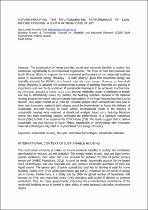 ResearchSpace
ResearchSpace
Future-proofing the environmental performance of low-income housing: a South African case study
JavaScript is disabled for your browser. Some features of this site may not work without it.
- ResearchSpace
- →
- Research Publications/Outputs
- →
- Conference Publications
- →
- View Item
| dc.contributor.author |
Ampofo-Anti, NL

|
|
| dc.date.accessioned | 2012-10-03T07:40:39Z | |
| dc.date.available | 2012-10-03T07:40:39Z | |
| dc.date.issued | 2012-09 | |
| dc.identifier.citation | Ampofo-Anti, NL. Future-proofing the environmental performance of low-income housing: a South African case study. Sustainable Human(e) Settlements: The Urban Challenge, Braamfontein, 18-21 September 2012 | en_US |
| dc.identifier.uri | http://hdl.handle.net/10204/6126 | |
| dc.description | Sustainable Human(e) Settlements: The Urban Challenge, Braamfontein, 18-21 September 2012 | en_US |
| dc.description.abstract | The construction of homes provides social and economic benefits to society, but contributes significantly to environmental degradation. The focus of both international and South African efforts to improve the environmental performance of the residential building sector is household energy efficiency – a valid priority, given that household energy use typically accounts for 80-90% of a home’s total life cycle energy. However, as household energy efficiency is attained, the environmental burdens of building materials are gaining in importance and need to be addressed if sustainable housing is to be achieved. Furthermore, the electricity demand of South Africa’s low-income residential sector is predicted to remain low, due to affordability issues. By contrast, the building materials demand of the national housing programme would need to increase substantially if the huge housing backlog is to be cleared. This paper reports on a CSIR BE research project which demonstrates how and in what way innovative material technologies could be implemented to foster the delivery of sustainable, low-cost housing in South Africa. International trends in the delivery of sustainable housing were reviewed. A situational analysis, based on a desk-top literature review and three modelling studies, compared the performance of a Standard Subsidised House (SSH) to that of an experimental CSIR House (CH). The results suggest that to deliver sustainable low-cost housing in South Africa, substitution of conventional with innovative material technologies may need to be prioritised over energy efficiency. | en_US |
| dc.language.iso | en | en_US |
| dc.relation.ispartofseries | Workflow;9602 | |
| dc.subject | South African housing | en_US |
| dc.subject | Low-income housing | en_US |
| dc.subject | Sustainable settlements | en_US |
| dc.subject | Household energy sufficiency | en_US |
| dc.subject | Standard Subsidised Houses | en_US |
| dc.subject | SSH | en_US |
| dc.subject | Energy efficiency | en_US |
| dc.subject | Sustainable housing | en_US |
| dc.subject | Innovative technologies | en_US |
| dc.subject | Sustainable building materials | en_US |
| dc.title | Future-proofing the environmental performance of low-income housing: a South African case study | en_US |
| dc.type | Conference Presentation | en_US |
| dc.identifier.apacitation | Ampofo-Anti, N. (2012). Future-proofing the environmental performance of low-income housing: a South African case study. http://hdl.handle.net/10204/6126 | en_ZA |
| dc.identifier.chicagocitation | Ampofo-Anti, NL. "Future-proofing the environmental performance of low-income housing: a South African case study." (2012): http://hdl.handle.net/10204/6126 | en_ZA |
| dc.identifier.vancouvercitation | Ampofo-Anti N, Future-proofing the environmental performance of low-income housing: a South African case study; 2012. http://hdl.handle.net/10204/6126 . | en_ZA |
| dc.identifier.ris | TY - Conference Presentation AU - Ampofo-Anti, NL AB - The construction of homes provides social and economic benefits to society, but contributes significantly to environmental degradation. The focus of both international and South African efforts to improve the environmental performance of the residential building sector is household energy efficiency – a valid priority, given that household energy use typically accounts for 80-90% of a home’s total life cycle energy. However, as household energy efficiency is attained, the environmental burdens of building materials are gaining in importance and need to be addressed if sustainable housing is to be achieved. Furthermore, the electricity demand of South Africa’s low-income residential sector is predicted to remain low, due to affordability issues. By contrast, the building materials demand of the national housing programme would need to increase substantially if the huge housing backlog is to be cleared. This paper reports on a CSIR BE research project which demonstrates how and in what way innovative material technologies could be implemented to foster the delivery of sustainable, low-cost housing in South Africa. International trends in the delivery of sustainable housing were reviewed. A situational analysis, based on a desk-top literature review and three modelling studies, compared the performance of a Standard Subsidised House (SSH) to that of an experimental CSIR House (CH). The results suggest that to deliver sustainable low-cost housing in South Africa, substitution of conventional with innovative material technologies may need to be prioritised over energy efficiency. DA - 2012-09 DB - ResearchSpace DP - CSIR KW - South African housing KW - Low-income housing KW - Sustainable settlements KW - Household energy sufficiency KW - Standard Subsidised Houses KW - SSH KW - Energy efficiency KW - Sustainable housing KW - Innovative technologies KW - Sustainable building materials LK - https://researchspace.csir.co.za PY - 2012 T1 - Future-proofing the environmental performance of low-income housing: a South African case study TI - Future-proofing the environmental performance of low-income housing: a South African case study UR - http://hdl.handle.net/10204/6126 ER - | en_ZA |





